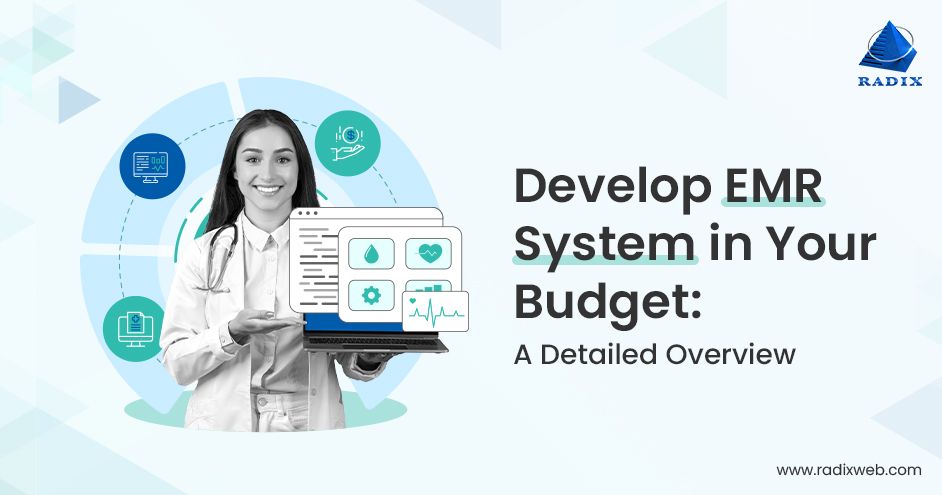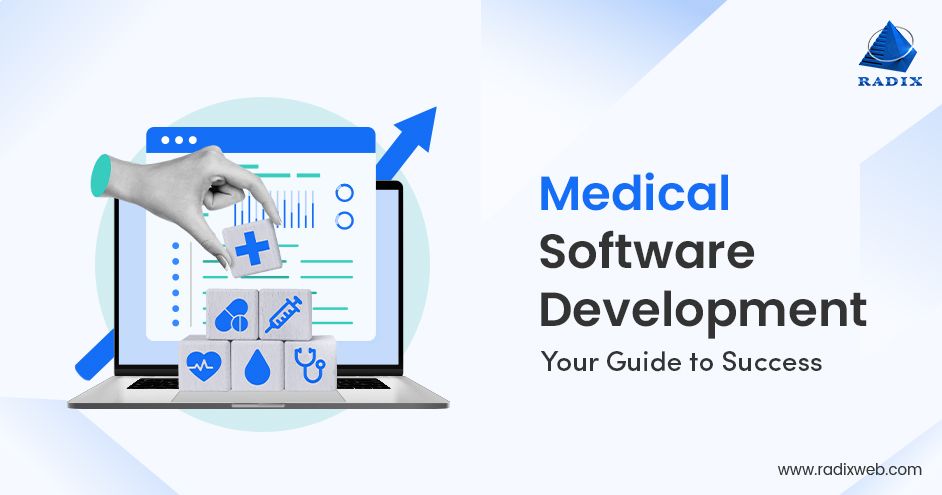Read More

Skip Setup Headaches and Start Your Project Fast - Download Free Boilerplates
A Complete Guide on EMR System Development: Features, Benefits, Cost

Quick Summary: With this guide you will know everything about EMR system development from essential features and types to development process. Read thoroughly to explore the excellent benefits of developing EMR software system and the process to build one.
Today, technology has become indispensable for every industry. The healthcare sector is not an exception. Technologies are evolving in this realm too, providing a wide range of options for patients and medical specialists.
EMR system is an ideal example of how technology is shaping the future of healthcare. EMR or Electronic Medical Record system is a software that offers a revolutionary way to manage patient information. This software enhances accessibility, improves patient care, and offers an effective way to keep medical records.
There was chaos with paper-based systems earlier because doctors had to deal with a pile of papers when referring a patient. But now with EMR software they have everything on their computer screen about a patient like medical history, radiology and laboratory data, diagnoses, medications, and more.
Therefore, the use of EMR software systems is increasing among medical specialists and healthcare organizations. Indeed, as per Centers for Disease Control and Prevention data, more than 88% of office-based physicians are using an EMR system in the USA.
If you are looking to develop an EMR system this guide is for you. It will provide information like the necessary features, tech stack, benefits, cost, and will walk you through the process of developing an EMR system. Let’s dive into the details.
Provide Better Access to Healthcare Services with a Custom EMR Platform
Build It Now
On This Page
What is EMR System and Why Build One?
An EMR system is a software program that represents patient charts electronically. It helps healthcare providers to store, share, and retrieve these charts conveniently. These charts contain patients’ health information like medical history, immunization, allergies, medication, diagnoses, etc.
Developing an EMR system is about creating a solution with tailor-made features that can meet specific requirements of a healthcare provider. Healthcare providers want to develop an EMR system for a wide range of advantages such as easy and quick processing of medical records.
There are lots of other benefits of EMR systems in healthcare as follows:
- EMR makes medical records readily available to different stakeholders.
- It cuts time in diagnosis and treatment with quick access to patient information.
- As the data is stored digitally, it can be saved for a very long time.
- They are flexible and customizable to the needs of healthcare providers.
- The system helps to prevent anomalies in medical records.
- Improve the efficiency of routine healthcare activities.
- The system provides better clinical support.
- Fast and reliable patient treatment.
- Better coordination among medical staff.
- Transparency in medical services.
Different Types of EMR Software You Can Develop
There is a wide variety of healthcare software like EMR that comes with different features designed to meet specific needs. Let’s see some popular types of electronic medical record solutions.

Acute Care EMR
These systems are designed exclusively for hospitals and facilities related to inpatient care. Acute care EMR systems handle the requirements of inpatient care efficiently. These systems are deployed to manage data related to the admission or discharge of patients and to track patient information. They are also used to manage complex information like medications, lab results, vital signs, etc.
Ambulatory EMR
These electronic medical record systems are designed to meet the requirements of outpatient medical facilities. Ambulatory EMRs are used in primary care clinics for patient registration, appointment management, e-prescribing, etc.
Specialty EMR
Specialty EMRs are used to meet the requirements of a specific medical specialty or healthcare setting like mental health, ophthalmology, and dermatology. There are different prebuilt templates and workflows that meet the unique requirements of a specific specialty.
Cloud-based EMR Systems
Cloud-based electronic medical record solutions (EMRs) are more cost-effective than on-premises EMRs. While you need to invest in IT hardware and software to host your EMR platform on-premises, cloud-based EMRs use scalable ready-to-use IT foundation with different pricing plans.
Hybrid EMR
Hybrid Electronic Medical Record is based on the combination of on-premises and cloud-based infrastructure. These EMRs use hybrid clouds to record and maintain patient information. Data can be accessed internally in the hospitals as well as over the internet.
Automate Your Medical Chores with a Custom Healthcare Software
Let’s Build It
Essential Features for EMR System Development
With an EMR system you can step into digital transformation in healthcare and digitize your infrastructure. But this step should be in the right way and choosing the best features is critical for this. Hence, you must carefully determine the features for your EMR system as listed below.

- Customizable Templates: A good EMR system will have templates that you can fill up easily with the required information. It will simplify and expedite the charting process. Plus, the EMR should also allow you to create custom templates.
- E-Prescriptions: Pick an EMR solution that allows sending e-prescriptions. It will help patients get medicines easily and allow doctors to prescribe more safely.
- Scheduling Features: It will help you easily keep track of appointments. The scheduling feature in EMR will also help you immediately notify patients about reminders, follow-ups, and appointments.
- Tools to Support Decision-making: Built-in tools like dosage calculators and drug interaction checkers help healthcare professionals make decisions.
- Data Sharing: Well-built EMR solutions will facilitate data sharing among laboratories, pharmacies, healthcare professionals, and other stakeholders to easily access patient records.
- Integration with Diagnostic Imaging Technologies: The integration of EMR with diagnostic imaging technologies allows healthcare professionals to view and store radiological data.
- High-end Security: EMR systems store and manage sensitive medical information that needs to be protected with robust security features.
- Reporting and Analytics: With this functionality, healthcare providers can track performance indicators and identify trends and patterns for improved services.
What Technologies Do You Need to Build an EMR System?
Creating a custom EMR solution requires a robust tech stack that can offer flexibility, scalability, and security. Plus, the technology should also align with your requirements and specifications. Hence, you should carefully pick your tech stack. The following are some of the best technologies for custom EMR software development presently.
Front-end
- AngularJS
- ReactJS
- VueJS
Backend
- Node.js
- Django
- ASP.NET
- PHP
Databases
- MySQL
- Cassandra
- MongoDB
- PostgreSQL
- SQLite
Cloud Platforms
- AWS
- Azure
- GCP
For Mobile Apps
- Java
- Swift
- React Native
- Flutter
- Ionic
How to Build an EMR Software from Scratch?
Now that you have understood the required features and tech stack for developing EMR software, let’s check out the stages involved in the process. There are five stages in developing this software which are given below.
1. Define Scope
The first thing you need to do is to be clear about your unique requirements. Identify your needs to build a software solution that aligns with your clinical workflow. For example, the EMR software should have templates, data management options, tools for clinical decisions, and other features that align to your specific specialty. So, you need to identify the features according to your specialty. Plus, you need to choose the right tech stack to build the software.
2. Prototyping
Before you build your EMR software, you should create a prototype. It is working replication of the software that will allow you to test and understand how it works.
3. Design and Development
UI/UX design is the next step in the development process. It involves creating enjoyable and responsive user interfaces that end users can interact with seamlessly. The interactive elements and visual components are created to define the user interface. In the development step, code is implemented to provide the desired functionality. Backend is set up, modules are created, and the software is built on the Service Oriented architecture.
4. Quality Assurance
In this stage, the EMR solution is tested on various parameters to ensure that it’s working as it is supposed to do. QA team will track bugs and errors to ensure that it functions properly and doesn’t show unexpected behavior. Besides, it is also tested for security and compliance.
5. Launch
The final stage is the deployment where the EMR is available to the end users. After the deployment, it can be easily accessed by the end users.
How Much Does It Cost to Build an EMR System?
Typically, the cost of EMR development ranges between $5,000 - $150,000. However, there is no simple answer to this question because it depends on the functionalities and complexity of the system. The requirements of different healthcare organizations vary based on their size, location, and type.
So, with varying needs, the cost of EMR software development can be more or less to the specified range. Solution type can also affect the cost, for example, the cost of a web-based electronic medical records system is different from the cost of an electronic medical record application.
Need Experts to Build Custom Healthcare Software for Your Organization?
Get Your Experts Now
The Bottom LineTechnologies like EMR are setting new standards for healthcare providers. They can leverage such technology to maintain crucial patient information electronically. It helps them avoid the lengthy, intrusive, and costly paper-based processes. Consequently, the healthcare providers can offer better patient care with reduced costs.There is an increasing demand for custom EMR systems today. The demand can be fulfilled by a reliable custom software development company like Radixweb that can build scalable EMR solutions. With a wealth of experience in this domain, we can develop the right solution that meets the specific needs of healthcare providers. We will build an EMR system with tailor-made functionality while aligning with regulatory compliances and industry standards. Contact our experts for answers to your questions about EMR software development.
About the Author
Milit is a talented Software Engineer with a strong passion for crafting innovative applications. With expertise in Angular, ReactJS, Dot Net Core, Web API, MSSQL, MySQL, Azure, Typescript, JavaScript, HTML, and CSS, Milit brings a diverse skill set to every project. His ability to seamlessly integrate various technologies and his commitment to writing clean and efficient code makes him an invaluable member of any development team.
Ready to brush up on something new? We've got more to read right this way.



